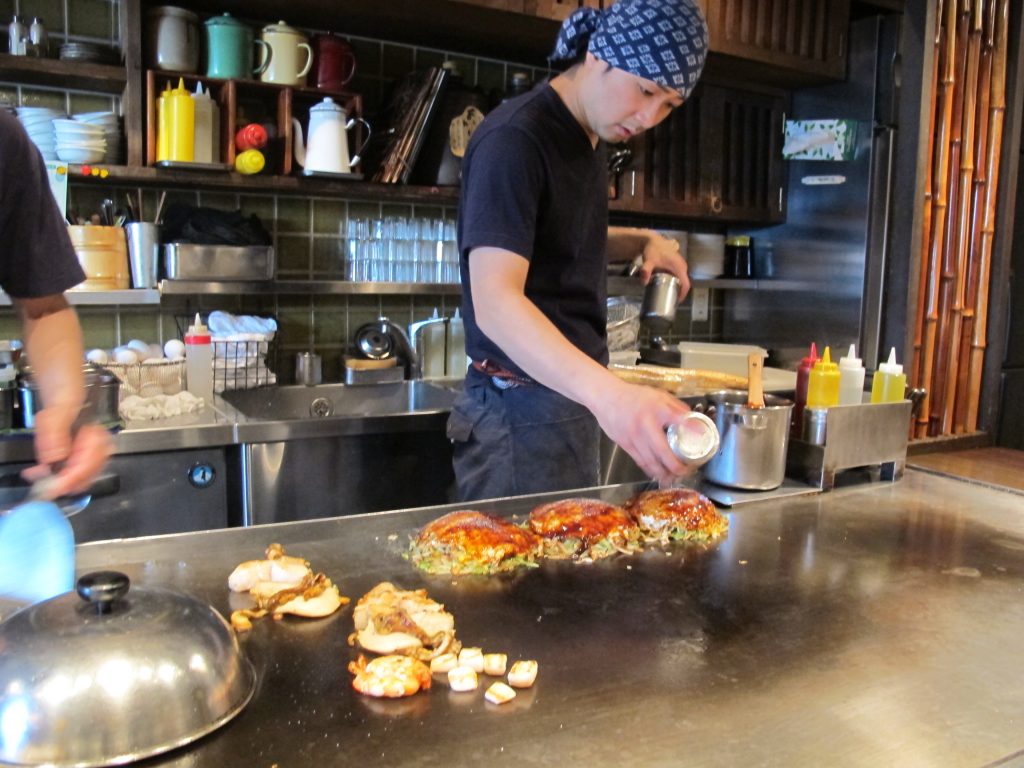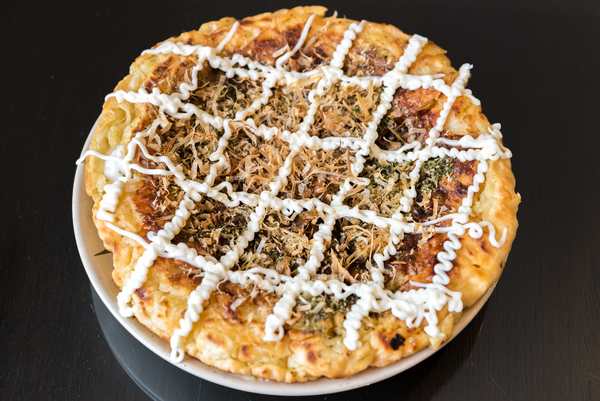An okonomiyaki is a Japanese salted pancake or pizza very popular in Japan and especially in Osaka which is eaten as a main dish and is generally shared with several people. It’s a very full flavoured and tasty dish.
You can customize it by choosing your topping (meat, fish, vegetables). Its preparation is quite simple and fast. However, you would need to have some Japanese ingredients that you can buy in Japanese grocery stores or on the internet.
The Japanese ingredients you will need for the okonomiyaki recipe are:
Ingredient for okonomiyaki Japanese pizza
1. okonomiyaki sauce, an essential ingredient in the development of a true okonomiyaki. This sauce gives the okonomiyaki all its flavour. You can buy some here.
2. Japanese mayonnaise Kewpie, it’s quite lighter than the normal mayonnaise. To learn more about it, follow this article.
3. Dashi powder for ease of use. You can make dashi yourself and it will only be better if you do. But if you prefer the east way or don’t have the tine you can buy Shimaya’s Dashinomoto or some other dashi brand soup stock, which will be perfectly fine.
4. A bag of kastuobushi. It’s dried and grated Bonito in fine shavings. They add character to the ensemble and bring a very pleasant visual touch. We recommend you buy from the brand Wadakyu, produced in Japan which is good and not too expensive.
5. Aonori which will bring a very pleasant taste of algae to the okonomiyaki pizza.

We have already tried with substitute ingredients like the ordinary mayonnaise for example, but the general taste suffers. If you want to rediscover the flavors of the real okonomiyaki you absolutely need these Japanese ingredients! Now it’s time for the recipe:
Preparation 10 min Cook 10 min Total time 20 min
Our recipe of okonomiyaki is enough for 1 pizza/ pancake
Ingredients
- 1 bag of katsuobushi “dried bonito”
- 1 mayonnaise kewpie
- 1 okonomiyaki sauce
- aonori
- 1 sachet of 10g dashi powder
- 1 egg
- 150 g of meat or fish
- Optional slices of fat”
- 2 leaves of chinese cabbage
- 1/2 bag of chemical yeast
- 100 g flour
Equipment needed:
- Salad bowl
- A spoon to mix
- A spatula for okonomiyaki
- A pan a griddle or a plancha”
Instruction
- In the bowl, mix the flour with the baking powder.
- In another bowl, heat 100 ml of water and add your dashi powder, then mix. We put half a pack if you want it to be more full-bodied in taste you can put 1 whole. Add this hot dashi to the flour / yeast mixture.
- Add the egg and stir. We get a smooth paste.
- Finely cut the Chinese cabbage leaves and add them to the batter.
- From this step you can add the filling of your choice, here from the shrimp and another to the chickens. You have to mix well in the bowl.
- All that remains is to cook it in a frying pan or at best on a crepe or to plant it on the table.
- Place the okonomiyaki paste on the skillet over medium heat to Brown the surface. 5 minutes on each side is enough, see if the raw filling is cooked well.
- You can turn it back with your spatulas. If you don’t have one, you can always buy this set of two really top spatulas for cooking. You will facilitate the daily life.
- We finish with the sauces.
- First the okonomiyaki sauce, draw short parallel lines on the okonomiyaki. In Japan they use a broad brush and generously coat everything.
- Then with Kewpie mayonnaise sauce
- Draw parallel lines from above.
- If you want to make patterns with a knife, simply slide the blade from one knife to the other.
- Sprinkle generously with katsuobushi. Then sprinkle some aonori and it’s ready !
Good appetite!
Some Tips and tricks
– You could add wasabi sauce with a light taste (after the Kewpie mayonnaise stage), we find that it brings a very interesting taste to the okonomiyaki. Even if it is not included as an ingredient in the original recipe you would certainly appreciate the addition of with this sauce!
You can add marinated red ginger “beni shoga” as garnish if you like. As a garnish idea, you can use scallops, cod, chicken, beef, calamari, etc. …
The okonomiyaki must have a rather thick consistency while being mellow in the mouth. This dish is very delicious when eaten with umeshu for example!

- Ingredients
- 1 bag of katsuobushi “dried bonito”
- 1 mayonnaise kewpie
- 1 okonomiyaki sauceaonori
- 1 sachet of 10g dashi powder
- 1 egg150 g of meat or fish
- Optional slices of fat”
- 2 leaves of chinese cabbage
- 1/2 bag of chemical yeast
- 100 g flour
- Equipment needed:
- Salad bowl
- A spoon to mix
- A spatula for okonomiyaki
- A pan or a griddle
- In the bowl, mix the flour with the baking powder.
- In another bowl, heat 100 ml of water and add your dashi powder, then mix. We put half a pack if you want it to be more full-bodied in taste you can put 1 whole.
- Add this hot dashi to the flour / yeast mixture.Add the egg and stir. We get a smooth paste.
- Finely cut the Chinese cabbage leaves and add them to the batter.
- From this step you can add the filling of your choice, here from the shrimp and another to the chickens. You have to mix well in the bowl.
- All that remains is to cook it in a frying pan or at best on a crepe or to plant it on the table.
- Place the okonomiyaki paste on the skillet over medium heat to Brown the surface. 5 minutes on each side is enough, see if the raw filling is cooked well.
- You can turn it back with your spatulas. If you don’t have one, you can always buy this set of two really top spatulas for cooking. You will facilitate the daily life.
- We finish with the sauces.
- First the okonomiyaki sauce, draw short parallel lines on the okonomiyaki. In Japan they use a broad brush and generously coat everything.
- Then with Kewpie mayonnaise sauce
- Draw parallel lines from above.
- If you want to make patterns with a knife, simply slide the blade from one knife to the other.
- Sprinkle generously with katsuobushi. Then sprinkle some aonori and it’s ready !Good appetite!
FAQ
How healthy is okonomiyaki?
However, the calorie and nutrient content of okonomiyaki can vary greatly depending on the ingredients and cooking method used. Some versions may contain high amounts of refined carbohydrates, such as white flour or sugar, or be cooked in oil and topped with calorie-dense sauces and mayonnaise, which can make them less healthy.
To make a healthier version of okonomiyaki, consider using whole grain flour or other nutrient-rich flours, such as chickpea or buckwheat flour. Use a minimal amount of oil to cook the okonomiyaki and opt for healthier toppings such as low-sugar sauces and additional vegetables.
Okonomiyaki is typically served hot, straight off the griddle or hot plate. It is a savory dish that is enjoyed as a main course or snack, and is often served in restaurants or at street food stalls in Japan. Some variations of okonomiyaki may be served with additional toppings, such as bonito flakes, nori seaweed, or Japanese mayo, which are also served at room temperature or cold.
Do you eat okonomiyaki with chopsticks?
What is okonomiyaki best paired with?
Okonomiyaki can be paired with a variety of beverages and sides depending on personal preference. Common pairings include green tea, or Japanese soda for beverages, miso soup, edamame, or Japanese pickles for sides, and various toppings such as okonomiyaki sauce, Japanese mayo, bonito flakes, nori seaweed, and pickled ginger.
What are the 2 styles of okonomiyaki?
There are two main styles of okonomiyaki: the Hiroshima style and the Osaka style.
- Hiroshima-style okonomiyaki: In this style, the ingredients are layered rather than mixed together. The batter is first poured onto the hot griddle or hot plate, followed by layers of shredded cabbage, bean sprouts, and pork belly or other proteins. Noodles (usually soba or udon) are then added on top of the vegetables, and an egg is cracked on top of everything. Finally, the whole thing is flipped over and cooked until the egg is set.
- Osaka-style okonomiyaki: In this style, the ingredients are mixed together in a batter and then poured onto the hot griddle or hot plate. The batter typically includes flour, dashi broth, and shredded cabbage, and other ingredients such as scallions, seafood, or meat can be added. Once the bottom is cooked, the okonomiyaki is flipped over and topped with a variety of sauces, including okonomiyaki sauce, Japanese mayo, and dried bonito flakes.
Do you flip okonomiyaki?
Yes, okonomiyaki is typically flipped once during cooking to ensure that both sides are evenly cooked. This is usually done using a spatula or two spatulas, depending on the size of the okonomiyaki. When the first side is fully cooked and golden brown, the okonomiyaki is carefully flipped over to cook the other side. Once both sides are cooked to your desired level of crispiness, the okonomiyaki is ready to be served.
Can you reheat okonomiyaki?
Yes, you can reheat okonomiyaki if you have leftover portions. One easy way to reheat it is to place it on a hot plate or in a frying pan and heat it over medium heat until it is hot and crispy. Another option is to use a microwave, but this may result in a softer texture. To reheat in the microwave, place the okonomiyaki on a microwave-safe plate and heat it for 1-2 minutes, or until it is hot throughout. If you have any leftover toppings or sauces, you can also reheat them separately and add them to the okonomiyaki once it is heated through.
Is okonomiyaki sweet or salty?
Okonomiyaki is a savory dish that has a balance of both sweet and salty flavors. The batter includes sugar for a slightly sweet taste, but the dish is also seasoned with savory ingredients such as soy sauce, Worcestershire sauce, and salt. Additionally, it is often topped with sauces such as okonomiyaki sauce and Japanese mayonnaise, which can add sweetness to the dish.
What is the sauce on okonomiyaki?
The sauce typically used on okonomiyaki is called okonomiyaki sauce, which is a thick and savory Japanese sauce with a sweet and slightly tangy taste. The sauce is similar in flavor to Worcestershire sauce, but it is thicker and sweeter. It is usually made with a base of soy sauce, Worcestershire sauce, sugar, and sometimes ketchup, and it is often drizzled over the top of the okonomiyaki just before serving. Some variations of okonomiyaki sauce may include additional ingredients such as dried bonito flakes to enhance the umami flavor.
Which cabbage is best for okonomiyaki?
The best cabbage to use for okonomiyaki is green cabbage. It is the most commonly used type of cabbage for this dish because it has a mild, slightly sweet flavor that complements the other ingredients in the batter. Green cabbage is also sturdy enough to hold up during cooking and does not become too watery when it is shredded. However, some recipes may call for a mix of green and red cabbage or napa cabbage for additional flavor and texture. Ultimately, the choice of cabbage depends on personal preference and availability of ingredients.
